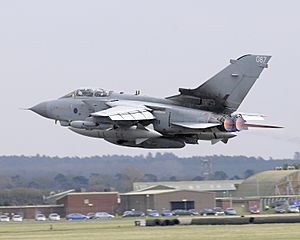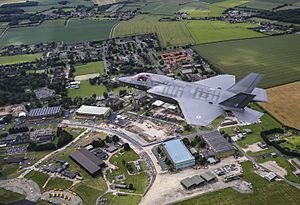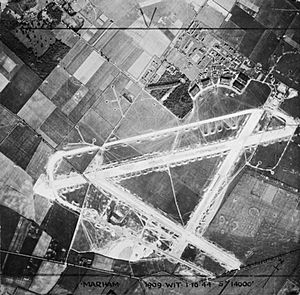RAF Marham facts for kids
Quick facts for kids RAF Marham
|
|||||||||
|---|---|---|---|---|---|---|---|---|---|
| Near King's Lynn, Norfolk in England, UK | |||||||||

A Lockheed Martin F-35B Lightning of No. 617 Squadron preparing to take off from RAF Marham, with a Tornado GR4 airborne in the background.
|
|||||||||

Deter
|
|||||||||
|
Shown within Norfolk
|
|||||||||
| Coordinates | 52°38′54″N 000°33′02″E / 52.64833°N 0.55056°E | ||||||||
| Type | Royal Air Force flying station, main operating base |
||||||||
| Area | 667 hectares (1,650 acres) | ||||||||
| Site information | |||||||||
| Owner | Ministry of Defence | ||||||||
| Operator | Royal Air Force | ||||||||
| Controlled by | No. 1 Group (Air Combat) | ||||||||
| Condition | operational | ||||||||
| Site history | |||||||||
| Built | 1916 | ||||||||
| In use | 1916–1919; 1937–present | ||||||||
| Garrison information | |||||||||
| Current commander |
Group Captain Fred Wigglesworth | ||||||||
| Occupants | No. 207 Squadron No. 617 (Dambusters) Squadron See Based units section for full list. |
||||||||
| Airfield information | |||||||||
| Identifiers | IATA: KNF, ICAO: EGYM, WMO: 03482 | ||||||||
| Elevation | 23.1 metres (76 ft) AMSL | ||||||||
|
|||||||||
| Other airfield facilities | 3x V/STOL pads | ||||||||
Royal Air Force Marham, or RAF Marham, is a Royal Air Force base located near the village of Marham in Norfolk, England. It is one of the main operating bases for the RAF.
Since 2018, RAF Marham has been home to the advanced Lockheed Martin F-35B Lightning fighter jets. These jets are flown by No. 617 (Dambusters) Squadron and No. 207 Squadron.
Contents
History of RAF Marham
Early Days (1916–1919)
RAF Marham first opened in August 1916 during the First World War. It started as a night landing area for military planes. At first, it was used by the Royal Flying Corps (RFC).
During the war, Marham's main job was to protect Norfolk from Zeppelin air raids. No. 51 Squadron was the first unit based here. They flew missions to defend the area. Marham also became a training base for pilots learning to fly at night. After the war ended in 1918, the base closed down in May 1919.
Rebuilding for War (1935–1945)
Work on a new airfield at Marham began in 1935. It officially reopened on 1 April 1937. This time, it became a base for heavy bomber planes.
Squadrons like No. 38 and No. 115 Squadron arrived, flying planes such as the Fairey Hendon and Vickers Wellington. Later, No. 218 Squadron flew the Short Stirling, and De Havilland Mosquitos from No. 105 Squadron also came to Marham.
In March 1944, RAF Marham closed briefly for a big upgrade. New concrete runways and other areas were built. This made it one of only two airfields designed for very heavy bombers.
The Cold War Era (1946–1982)
After World War II, RAF Marham was used for special tests. From 1946, it hosted American B-17 Flying Fortress and B-29 Super Fortress planes. They tested powerful bombs against strong concrete targets.
In 1950, the first of 70 Boeing Washington B.1 planes arrived at Marham. During the 1950s, Marham was home to English Electric Canberra jets. Later, it became a base for the famous V-bomber force, which included the Vickers Valiant and Handley Page Victor planes. These were important for the UK's defense during the Cold War.
The Tornado Years (1982–2019)

Between 1980 and 1983, special hardened shelters were built for new strike aircraft. In 1982, the Panavia Tornado GR1 arrived. No. 617 (Dambusters) Squadron reformed here in 1983, followed by No. 27 Squadron.
The Tornado GR4 aircraft from Marham took part in many operations. In 2011, they flew long missions to strike targets in Libya during Operation Ellamy. In 2014, Tornados from Marham began airstrikes against ISIL as part of Operation Shader.

The Tornado GR4 fleet was gradually retired. The last eight deployed Tornados returned to RAF Marham in February 2019. To say goodbye, RAF Marham held special 'farewell flypasts' across the UK. The very last RAF Tornado flight happened on 14 March 2019. The Tornado GR4 was fully retired on 1 April 2019, making the F-35 Lightning the only type of jet based at Marham.
Project Anvil (2016–2018)
Project Anvil was a huge £250 million project to get RAF Marham ready for the new F-35B Lightning jets. This involved building many new facilities and upgrading old ones.
New buildings included a Lightning Maintenance and Finish Facility and a new squadron building for No. 617 (Dambusters) Squadron. The Lightning National Operating Centre (NOC) was also built. It was opened by the Queen in February 2018.
The project also included rebuilding Marham's runways and adding vertical landing pads for the F-35B. Both runways were rebuilt in just three weeks in 2017. All these upgrades were finished by June 2018.
The F-35B Lightning Era (2018–Present)

In 2013, it was announced that all British F-35B Lightning jets would be based at RAF Marham. These advanced jets are designed to take off and land vertically (STOVL). They can also operate from the Royal Navy's aircraft carriers.
The first four F-35Bs arrived at Marham on 6 June 2018, after an eight-hour flight from the USA. No. 617 (Dambusters) Squadron became the first operational F-35 unit in January 2019. No. 207 Squadron also reformed here in August 2019, becoming the training unit for F-35 pilots.
In January 2020, F-35Bs from No. 207 Squadron flew from HMS Queen Elizabeth. This was the first time in ten years a British squadron operated jet aircraft from a British aircraft carrier in home waters. In September 2020, American F-35Bs from the United States Marine Corps (USMC) also arrived at Marham to train with the Dambusters.
What RAF Marham Does Today
Leadership and Role
Group Captain Phil Marr became the commander of RAF Marham in July 2021. The base is near the Royal Estate of Sandringham. Queen Elizabeth II was the station's Honorary Air Commodore and visited the base many times.
RAF Marham is part of No. 1 Group (Air Combat) RAF. Its main job is to operate the F-35B Lightning jets.
F-35B Lightning Operations
RAF Marham is the home for the F-35B Lightning jets. No. 617 (Dambusters) Squadron is a front-line squadron, meaning they are ready for missions. No. 207 Squadron trains new F-35 pilots and ground crew.
Expeditionary Air Wing
No. 138 Expeditionary Air Wing (No. 138 EAW) was created at Marham in 2006. Its purpose is to help create and manage parts of the air force that can be sent to different places around the world.
Other Units at Marham
RAF Marham also supports other important units:
- RAF Holbeach — a bombing range used for training.
- RRH Neatishead — a radar station.
Units Based at RAF Marham
Here are some of the main flying and non-flying units based at RAF Marham:
Royal Air Force
|
British Army
Civilian
|
RAF Marham's Heritage
Station Badge and Motto
RAF Marham's badge was given to it in 1957. It shows a blue bull with its head lowered. The bull represents strength and being ready to defend. The station's motto is Deter, which means to stop someone from doing something, showing its role in defense.
Gate Guardians
RAF Marham has special planes displayed at its entrance and around the base. These are called gate guardians. In March 2020, a Tornado GR1 (ZA407) was moved from the gate. It was replaced by another Tornado, GR4 ZA614.
There is also an English Electric Canberra PR9 (XH169) on display inside the base. Until November 2020, a Handley Page Victor K2 (XH673) was outside the headquarters building.
Images for kids
-
Boeing Washington B1 WF502 of No. 90 Squadron, 1952. This squadron was based at Marham between 1950 and 1956.
-
De Havilland Mosquito B.IVs of No. 105 Squadron at RAF Marham during WWII. This squadron was based at Marham between 1942 and 1944.
-
Panavia Tornado GR1 ZA494 of No. 27 Squadron, 1984. This squadron was based at Marham between 1983 and 1993.
-
Handley Page Victor K2 XH672 of No. 55 Squadron at RAF Marham, 1993. This squadron was based at Marham between 1966 and 1993.
-
English Electric Canberra PR9 XH131 from No. 39 (1PRU) Squadron, 2006. This squadron was based at Marham between 1993 and 2006.









